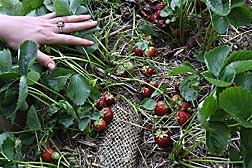This page has been archived and is being provided for reference purposes only. The page is no longer being updated, and therefore, links on the page may be invalid.
Read the magazine story to find out more. |
|
|
Socking It to Strawberry Root Rot
By Don ComisSeptember 24, 2007
Strawberry plants grown in compost-filled mesh tubes, or “socks,” had significantly less chance of getting black root rot, a severe threat to yields, than plants grown directly in infested soils in an Agricultural Research Service (ARS) study.
No methyl bromide or any other soil fumigant was used in the study, since they have become too costly for many small growers and nonchemical alternatives are being sought. The sock plants yielded 16 to 32 times more fruit than those from the conventional "matted row" or black plastic mulch systems when grown in infested soil with no soil treatment.
The compost socks lay on top of the infested soil. The disease didn’t migrate into the socks and roots of the strawberry plants during the first growing season, as it did into the strawberry plant roots growing in infested soil. Drip irrigation provided water and supplemental nutrients to the plants in the compost socks.
Microbiologist Patricia D. Millner, with the ARS Sustainable Agricultural Systems Laboratory in Beltsville, Md., conducted this study—the first of its kind for strawberries.
Small strawberry growers in the northern United States tend to use perennial matted rows, in which the runners self-root and form living mats. Some operations that grow strawberries as annual plants use black plastic mulch. Soil fumigants are used to control root diseases, weeds and nematodes.
In addition to horticultural production, compost socks are often used for road and stream bank stabilization, flood control, and to hold back silt at construction sites.
Millner experimented on three farms in central Maryland, each with different soil types. She rated the root health of the strawberry plants on a scale of 1 to 5, with a rating of 5 meaning the plants were totally free of root rot. All but one plant grown in the compost socks scored 4 or 5, while those grown in matted rows or plastic scored from 1 to 3, except for one rating of 4. A study comparing compost socks with fumigation and crop rotation is being completed.
Read more about the research in the September 2007 issue of Agricultural Research magazine.
ARS is the U.S. Department of Agriculture’s chief scientific research agency.

